News and Announcements
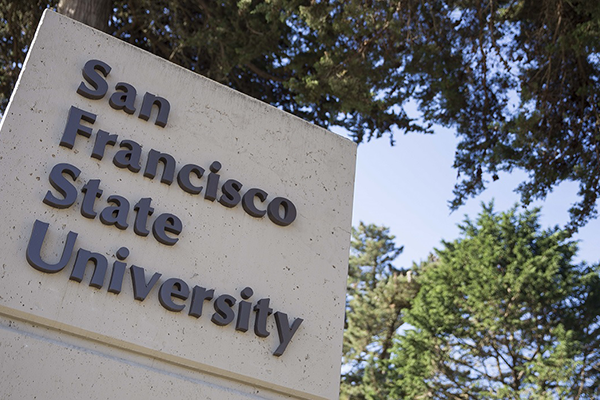
SF State has been awarded a 4.5 out of 5 star rating by Money magazine in its Best Colleges in America 2023 list. Money based its rating on SF State’s quality of education, affordability and outcomes compared to other universities.
Though in the past Money assigned numbered ranks to U.S. colleges, this year’s list used a star system. Of 736 colleges reviewed, only 34 received 5-star ratings, and 190 were given 4.5 stars. In 2022, SF State was #75 on Money’s list of Best Colleges in America, Ranked by Value.
This year’s Money review cited a strong commitment to community service as “a key feature of San Francisco State’s programs.” It also mentioned the opportunities for field work at the University’s Estuary & Ocean Science Center and Sierra Nevada Field Campus. And alumni accomplishments were cited, as well.
“The school takes pride in its entertainment-oriented coursework, such as cinema, music, and writing, and counts an impressive number of Oscar, Emmy and Pulitzer Prize nominees among its alumni,” Money’s editors wrote.
This isn’t the first time SF State has been prominent in college rankings this year. In May, it was No. 5 on the Wall Street Journal’s list of Top 20 Public Colleges for Accounting Students. In March, it was ranked No. 15 on a US News and World Report list of Top Performers on Social Mobility. And in February, it was on The Princeton Review’s 2023 Best Business Schools list.

Have you ever considered the stars in the night sky and wondered how many are orbited by planets like ours? Astronomy and Physics Assistant Professor John Michael Brewer has … and he’s getting answers. He’s the latest in San Francisco State’s long list of planet hunters hoping to find new planets comparable to our Earth. He and his collaborators are inching closer to their goal with their new discovery.
Their latest report describes the detection of two new exoplanets in what was believed to be a two-planet system. The new exoplanets are the first to be discovered in the 100 Earths Survey, a project led by Brewer that uses an extremely precise new tool to detect planets previously beyond scientists’ reach. The findings have been accepted to the Astronomical Journal but the preprint is already available on arXiv.
The new exoplanets orbit rho Coronae Borealis, a star about the same size as our sun. Two large planets were already known to orbit this star. But the new survey discovered a third planet that’s much smaller (four times the mass of the Earth, which is considered small) with a 13-day orbit and a fourth planet that’s similar to Neptune (20 Earth masses) with a 280-day orbit.
“If we’re going to find an Earth-like planet, it has to be around a sun-like star. This is exactly the kind of star that we want to be looking around. But we haven’t been able to find small planets like Earth in long-period orbits around these types of stars before,” Brewer explained. “This one study doesn’t tell us [whether our solar system is unique], but at least it tells us that we can start seeing whether or not there’s [Earth-like] planets [around sun-like stars].”
Usually astronomers find small Earth-like planets with orbits less than 40 days around small stars. But the Earth orbits the sun (which is slightly more massive than rho Coronae Borealis) every 365 days. Although the new small planet is uninhabitable because it’s too close to its star, its discovery shows that the new survey expands the types of planets scientists can detect.
Prior research found that the planetary system around rho Coronae Borealis consisted of a large planet (330 Earth masses) with a 39-day orbit discovered in 1997 and a second smaller one (25 Earth masses) with a 102-day orbit found in 2016.
The two new planets and the previously discovered planets make up a four-planet system that is not arranged like our solar system, where planets grow in size the further away they are from the sun. However, this four-planet system’s arrangement is rare, giving hope that the 100 Earths Survey might be able to detect other uncommon planetary systems.
“Now we’re starting to look at what planet architectures really look like instead of just the glimpses we’ve been able to see until now,” Brewer said, explaining that these types of systems were below detection limits. The 100 Earths Survey started in 2019 and not only confirmed the first two planets and discovered the two new ones, it also found hints that there might be more planets in this system. It managed to do all this with just 163 observations in under three years — which is fast compared to previous surveys. The planets detected in 2016 required 800 observations over eight years to find one new planet and one old.
The quick pace of discovery was made possible by using EXtreme PREcision Spectrometer (EXPRES), a spectrometer housed at the Lowell Observatory’s Lowell Discovery Telescope in Arizona. Designed by former San Francisco State Assistant Professor and alumna Debra Fischer, EXPRES measures light from a star to measure changes in its velocity as it is tugged around by its planets. Though EXPRES is not the first device of its kind, its level of high resolution and ability to cut through noise in measurements is matched by only a few other spectrographs in the world.
“We’re starting to probe the space where we expect to find habitable planets,” Brewer said. “Hence the name of the 100 Earth Survey. We want to find a bunch of Earth-like planets.”
Brewer started his master’s degree at SF State before moving to Yale University to work on his Ph.D. with renowned planet hunter Fischer. Now that he’s leading the project, Brewer wants to involve more of his students. The 100 Earths Survey and EXPRES have been collaborative since the beginning, providing a great learning opportunity for students, Brewer explained, noting that he’s already looping his students into tangential projects.
“There’s only 15,000 astronomers in the world,” Brewer said, explaining why it’s important for SF State students to mingle with the science community early in their career. “Everyone knows something slightly different, and everybody brings something else to the table. And that’s crucial to building students’ thinking whether they go on to a Ph.D. program or industry.”
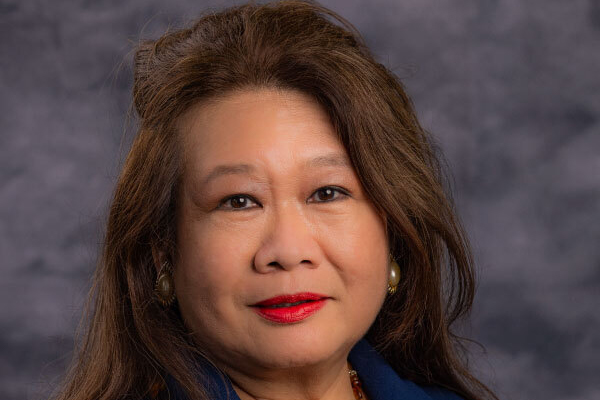
Gerontology Professor Darlene Yee-Melichar has been appointed to the CSU Board of Trustees, California Gov. Gavin Newsom announced on June 29.
“California’s world-class colleges and universities are a point of pride that serve diverse and thriving communities across the state, shaping our future leaders and innovators and driving our economic growth,” Newsom said. “These appointees will bring their unique backgrounds, perspectives, and lived experiences to the ongoing work of ensuring our campuses are places where all belong.”
CSU Board of Trustees Chair Wenda Fong welcomed Yee-Melichar at the Board of Trustees meeting on July 11.
“I know that I speak for all of the Board when I say we look forward to collaborating with you — learning from your lived experience, intellect and heart that you will bring to the CSU,” Fong said.
Yee-Melichar is coordinator of Gerontology in the School of Public Affairs and Civic Engagement.
The Office of the President and the Academic Senate cordially invite you to the 2023 San Francisco State University Opening Convocation, which will be held in the McKenna Theatre Thursday, Aug. 17. The kickoff to the new academic year will begin with coffee and pastries at 8:15 a.m. at the Holloway entrance to the Creative Arts building, then continue in the McKenna Theatre with campus leaders introducing new community members and highlighting campus plans and accomplishments. A gala reception will follow, with information tables from campus programs, offices and groups on the Fine Arts patio. The event will end by 12:30 p.m.
Come learn about your university, see old friends, meet new colleagues and get the academic year off to a fantastic start!
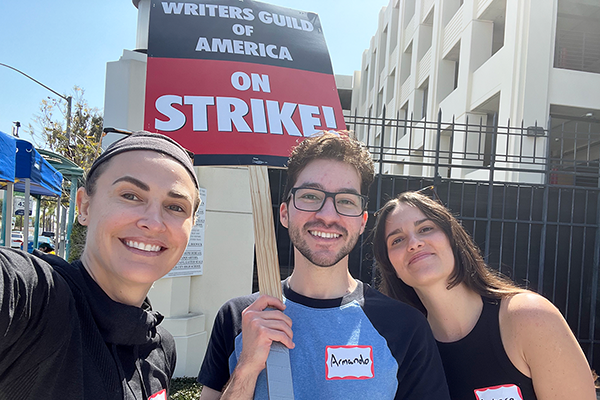
For many SF State graduates with Hollywood dreams, moving to Los Angeles is a move for opportunity. While the Writers Guild of America (WGA) strike has brought production to a halt industrywide since May, two former SF State students have placed themselves on the picket lines alongside one of their faculty mentors.
“It’s history in the making, so why wouldn’t you want to be there and try to make a change?” said Barbara Burgues, a Venezuela native who attended SF State in 2021 and now lives in Los Angeles with goals of producing, writing and directing.
Her former SF State classmate Armando Jimenez picketed with her. Jimenez (B.A., ’22) is an aspiring screenwriter and director who moved to Southern California in the spring.
“It’s natural for me to join the picket line. I get to fight for my future,” he said. “Especially since I’m hoping to get a job somewhere in that field; I hope to be able to afford the roof over my head.”
Burgues and Jimenez were invited to the picket line by Marion Dayre, a lecturer in Broadcast and Electronic Communication Arts and executive story editor on the Emmy Award-winning “Better Call Saul.” (Streaming soon: She is the head writer on Marvel’s “Echo” and co-showrunner on Amazon Prime’s “Wytches.”)
Dayre structures her “Television and Video Program Design” class to simulate the full preproduction process of developing a series for streaming. Writing is a major element, but students also learn to build a pitch and other tricks of the trade. As a rising star on the front lines, Dayre tells her students what conversations are like in the writers’ rooms and network executive suites, with self-care in mind.
“If students are asking if they’re capable, I hope they would be able to find that assurance going through the process of the class,” Dayre said. “What I try to pass along is the importance of self-care as a writer. Knowing that we’re in a community with our anxieties, we don’t have to harbor them alone and navigate them alone. I try to come and be real.”
But then comes the question of existential doom: Is it a good time to move to Los Angeles to break into the industry?
“It’s always risky and it’s always full of rewards. And I think now’s as good a time as any,” Dayre said. “I moved to LA during the last strike [in 2007 – 2008]. And everything worked out.”
Shrinking seasons, shrinking compensation
WGA members are striking to seek increases and equity in pay, improvements in work conditions and job security, measures to prevent harassment and discrimination, and the regulation of material generated with artificial intelligence. The guild is bargaining with the Alliance of Motion Picture and Television Producers.
“When I was watching television in the 1950s, there were 39 episodes a season. The same shows were on year after year, and they were all advertiser-driven,” said David Pollock (B.A., ’61), a retired Emmy Award-winning writer from classic programs such as “Frasier,” “The Mary Tyler Moore Show,” “The Carol Burnett Show” and “M*A*S*H*.”
“Over the decades, incrementally, the number of episodes shrunk as the business expanded,” added Pollock, now retired but still a frequent WGA picketer. “We’re just burning up content faster and faster with shorter attention spans.”
‘Another pause for the greater good’
Dayre says the camaraderie that it takes to write a quality script begins in the writers room and continues on the picket line, where she is a captain.
“We had a slowdown during COVID, and now it comes time to take another pause for the greater good,” said Dayre, who has taught at SF State since 2021 and been a WGA member since 2014. “You’re never guaranteed the next job or the next spot, but you are guaranteed the ability to learn from brilliant writers and to help them when you can.”
Jimenez says picketing has been a fun way to effect change and learn about the business side of entertainment. As an extra motion of solidarity, one day he brought two cases of water for the protestors.
“I’m not a WGA member and, fortunately, you don’t have to be a WGA member to join the picket line. Nobody minds at all,” said Jimenez, who interns in project development for Dayre. “They have such a great community of people. I don’t usually see something so tight-knit where an entire huge group of people go, ‘Oh, we’re going to go on strike. We’re all going to do this.’ Plus, spending time with someone like Marion, it gives me comfort for the future.”
Burgues only spent one semester at SF State, but it’s changed her life. She credits the University for sparking her creativity, and Dayre is a vital inspiration.
“She’s just so understanding of how hard it can be to get into this industry, and it’s very easy talking to her,” Burgues said. “If it weren’t for her, I don’t think I would have had the courage to tell my parents, like, ‘Hey I’m going to be a writer and leave everything behind and just be a struggling international student.’ And I do not regret it at all.”
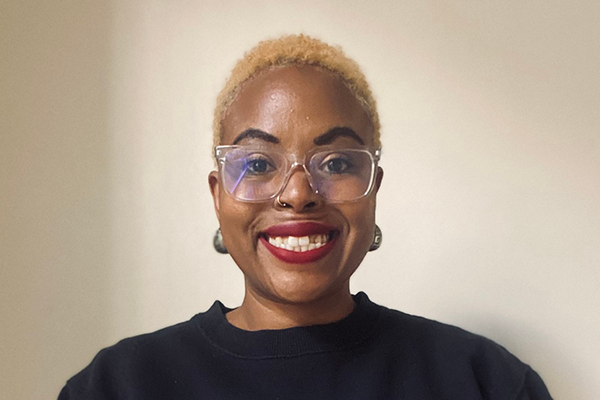
On March 22, 2023, the CSU Board of Trustees adopted a resolution designating June 19 (Juneteenth), which was recognized as a federal and California state holiday in recent years, as a paid holiday for CSU employees effective this calendar year. Ahead of the holiday this year, we spoke to Assistant Professor of Africana Studies Tiffany Caesar, who looked back on the history of the holiday and shared what it means to her and ways to celebrate this year.
What is Juneteenth?
Juneteenth National Independence Day celebrates the emancipation of slaves in Galveston, Texas, signifying the end of slavery in all states. Juneteenth stands for June 19, 1865, when General Gordon Granger read General Order No. 3 on Galveston Island affirming that all slaves were in fact free. Though the Emancipation Proclamation was published in 1863 declaring that ‘all persons held as slaves’ within the rebellious states ‘are, and henceforward shall be free,’ not all states adhered to those orders declared by former President Abraham Lincoln.
It was not until June 19, 1865 — two and half years after the Emancipation Proclamation, and several months after the passing of the 13th Amendment — that all slaves were free. African Americans have celebrated the holiday yearly and on June 17, 2021, it officially became a U.S. holiday with the advocacy of activist Opal Lee, known as the grandmother of Juneteenth.
It became a holiday in Texas in 1980. Juneteenth is also called the second independence day. However, I would argue it is the first as civil rights movement leader Fannie Lou Hammer states, “No one is free until everyone is free.”
What are ways we can celebrate Juneteenth?
There are many things locally you can do in San Francisco to celebrate Juneteenth. If you follow S.F. Black Wallstreet on Instagram, they have curated multiple programs you can do for the holiday.
You can also read and watch many things that document the history of Juneteenth, such as a Smithsonian Institution article on the historical legacy of Juneteenth and a piece by literary critic Henry Louis Gates, Jr. that explains what Juneteenth is as well as an interview with Lee.
What are some of your favorite memories of celebrating Juneteenth in the past?
My favorite memories of celebrating Juneteenth occurred when I was a fellow for the Institute for Social Justice and Race Relations at Jackson State University during the summer of 2022. We had special speakers discuss the importance of Juneteenth, there was live music, games and great food! It was truly an experience that joined knowledge of the historic moment and fun for all in a true community way.
How are you celebrating Juneteenth this year?
I'm joining the festivities in San Francisco. I would love to go to Galveston, Texas, the birthplace of Juneteenth to celebrate one day. There are several activities you can participate in there, including the Juneteenth Symposium “Sounds of Freedom.”
What makes the holiday special and important to celebrate today?
It is important to know that the Emancipation Proclamation did not free all the slaves. Even though there were executive orders to do so, some plantation owners chose to withhold that information for fear of losing their labor. The holiday represents liberty for Black people in America. Even though there are continued challenges as it concerns racism and disenfranchisement, it is still seen as a victory that on June 19, 1865, all slaves were finally free.
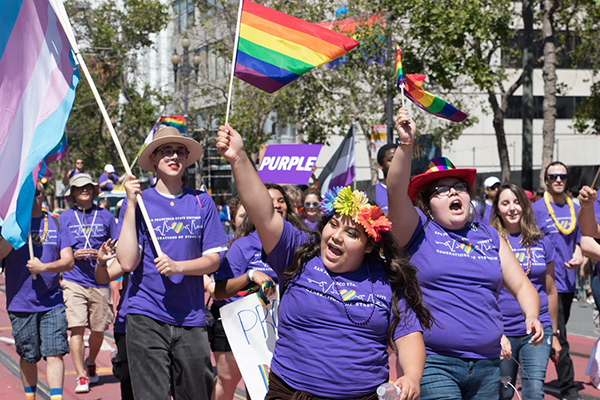
As the annual celebration of Pride Month began, state legislators across the nation introduced a record-breaking number of bills that threaten LGBTQ rights and health.
According to a June 6 statement by Human Rights Campaign, more than 525 anti-LGBTQ bills have been introduced in 41 states since the start of 2023. Of these, 76 have been enacted into law — more than twice as many as in the entirety of 2022, which set the previous record. Among them are laws that mandate censorship of school curricula to exclude mention of LGBTQ lives or experiences, roll back LGBTQ anti-discrimination protections, outlaw drag or ban gender-affirming care for transgender youth.
SF State Professor of History Marc Stein, who has written extensively about LGBTQ history, said politicians and pundits are employing the same strategies to target LGBTQ rights that they’ve used for decades: inciting “moral panics” and framing the issue as one of protecting children.
“In the past, cultural discourses about sexual ‘perverts’ and gender ‘deviants’ played up the innocence of youth, who were seen as vulnerable to enticement, grooming, recruitment and seduction,” Stein said. “This led, for example, to the passage of ‘sexual psychopath’ laws in many states in the 1930s, 1940s and 1950s. In the 1970s, similar dynamics led to Anita Bryant’s ‘Save Our Children’ campaign against sexual orientation anti-discrimination laws and to California’s Briggs Initiative, which targeted LGBT teachers and their allies.”
In fact, children are the most vulnerable to the messages sent by anti-LGBTQ laws, according to Caitlin Ryan, director of SF State’s Family Acceptance Project. In her work with diverse families across the country, Ryan has heard directly from LGBTQ youth and families who reported increased anxiety, feelings of hopelessness, uncertainty about the future and fear of hate-driven violence. Some of the families considered moving to other states, Ryan says, but laws have a harmful effect even across state lines.
“Hate has no borders. The impact of what the governor is doing in Florida, and what some lawmakers are doing in other states, really reverberates across the whole country. The targeted disinformation about LGBTQ lives is poisonous,” Ryan said.
Ryan and the Family Acceptance Project have conducted 22 years of research showing the impact of negative and positive messages about sexual orientation and gender identity on the health of LGBTQ youth. They found that suicide, illegal drug use and HIV infection are among the increased health risks for LGBTQ youth who receive negative messages, especially when they are reinforced by family or caregivers.
“The laws that ban even talking about LGBTQ people tell children and adults that these identities are so unspeakable, we can’t even talk about them in front of children. They spread distortions about LGBTQ identities and who LGBTQ people are, and they dehumanize our lives,” Ryan said.
Ryan points out that “don’t say gay” laws prevent LGBTQ children from discussing their identities and their lives in the very place where they do the most socializing, and this may inflict long-lasting damage. According to a Family Acceptance Project study, children who came out in school were shown to have better social adjustment and mental health as young adults than those who hid their sexual orientation or gender identity.
Anti-LGBTQ laws also endanger the providers and teachers whose support has been a lifeline to LGBTQ youth and who now must consider their own legal jeopardy. Ryan believes that culturally relevant education and guidance, such as that developed by the Family Acceptance Project, must be made available to families, caregivers, teachers and providers to help them understand the profound impact that their response to LGBTQ identity has on a child’s health and well-being.
“This is essential, especially now, in this increasingly hostile environment,” Ryan said.
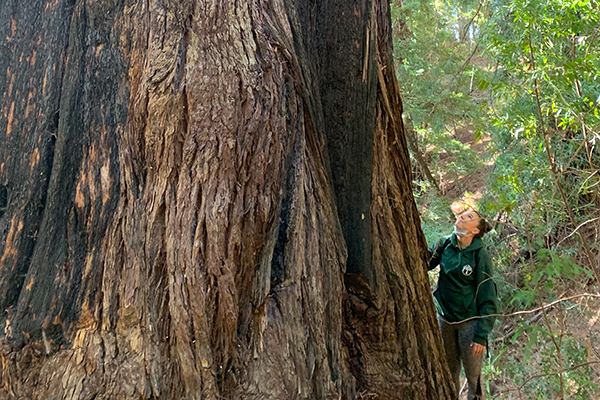
Remember in grade school learning to count tree rings to determine a tree’s age? Turns out tree rings can reveal climate information, too, says SF State student Triana Anderson. For her thesis project, she is applying a novel approach to use trees as a gauge for coastal climate change over thousands of years. Her expertise has earned her a Fulbright scholarship to do a parallel project in Chile for nine months after she graduates this fall.
“The idea is that Chile and California have two very parallel climate systems, but one is in the northern hemisphere. There are a lot of questions that climate scientists have about how coastal systems will change as the planet warms,” said Anderson, an Earth & Climate Sciences master’s student. Studying trees in California and Chile will help identify how climate change differs in the two hemispheres.
Anderson has unknowingly been preparing for this Fulbright adventure her whole life. Having grown up in Northern California, she spent a lot of time outdoors listening to her dad describe how the coast has changed since his childhood. “I think that helped bring a climate change perspective at a young age — even though I wouldn’t have called it that as a kid,” she said.
Her choice to study in Chile? That was also intentional. She attended Spanish-speaking immersion schools since she was 5 years old, loving it so much she minored in Spanish as an undergrad.
“I think it’s always been a goal to go live in a Spanish-speaking country and fully solidify those pathways that are in my brain,” she explained. She’s excited that a Fulbright experience will fuse her scientific and personal goals.
The novel technique she’s taking to Chile was developed at SF State. Anderson came to the University after cold calling and instantly clicking with her future thesis adviser, Associate Professor Alexander Stine. He introduced her to the idea of using trees to evaluate climate change, and she was hooked on the idea.
Traditionally, scientists — like those in Chile — measure variability in tree ring width to determine climate fluctuations. Some researchers glean more info by looking at the cellular structure of wood but are limited by the small sample of wood cells they can manually assess under a microscope.
For her graduate work, Anderson coupled a new high-resolution imaging technique to assess cellular structure with an artificial intelligence algorithm to take mass measurements of lots of cells from lots of trees. It allows her to look at both temperature and precipitation changes together, whereas traditional methods force scientists to focus on temperature or precipitation separately. Because she can look at larger sample sizes, she can also average out noise from confounding variables like insect infestations or competition between species.
She’s been using this approach to study changes in California’s coastal climates. Studies show a decline in coastal fog over the last 100 years, but Anderson points out that’s a relatively short period of time when considering climate trends. Her study uses coastal redwoods to look at climate changes over 2,000 years.
“[Redwoods] live that long, which is insane. It’s crazy to think that there are living organisms that have experienced all of that history,” Anderson said. The Chilean researchers are eager to apply her approach in their studies.
She’s not entirely sure what will come after the Fulbright, but she hopes teaching is in the mix. At SF State, she excitedly elected to teach an oceanography class for non-science majors. She’s glad that community work is part of her Fulbright program, too. She’s hoping to teach science education or youth girls’ sports in Chile.
“I love working with kids. I think it’s so cool to watch their brains make all those little connections,” she explained, noting that the youngest community members are the ones to be most impacted by climate change.
The Lam Family College of Business congratulates the outstanding faculty honored with a Lam-Larsen Distinguished Professorship Award for 2023 – 2025, recognizing their exceptional contributions in:
- Research: Foo-Nin Ho, Venoo Kakar, Antoaneta “Toni” Petkova, Robert Saltzman, Lihua Wang
- Teaching: Robert Bonner, Stewart Liu, Smita Trivedi
- Service: Anoshua Chaudhuri Theresa Hammond
Cal State Innovate accepted proposals for Innovation Minigrants for 2023 –2024 to support innovative projects, pilots or prototypes on campuses, prioritizing proposals that address student recruitment and retention challenges that leverage a technology solution. Academic Technology and Information Technology Services (ITS) received multiple innovative project submissions from faculty and staff across the SF State campus. The Chancellor’s Office has selected the ITS Web and Mobile Team as the winner. The developers will receive $10,000 for their work with mobile push notifications that support student recruitment and retention challenges.
The campus will welcome students moving into the housing community on Friday, Aug. 11, and Saturday, Aug. 12.
In preparation for their arrival, please be aware of traffic congestion in and around the campus perimeter, particularly on Winston Drive, Lake Merced Drive and Font Boulevard. Many of the streets bordering the campus along with Lot 20 may have restricted parking on these days, so please plan accordingly when arriving to campus.
Want to join in on the fun? Move-in ambassadors are needed to help with wayfinding and welcoming students and families and helping them with wayfinding. Complete the sign-up form on Google Docs.
The Writing Program and English Department have published the seventh annual volume of Sutro Review: SF State Journal for Undergraduate Composition, featuring writing and artwork from across campus. The student editors chose the theme of Unmasking, revelations on identity and what lies beneath the mask.
This year’s journal was led by Caroline Casper and a team of three student editors (Caitlin Darke, Professional Writing and Rhetoric major; Carina Thanh-Ngoc DeLorenzo, English Literature major; and Osvaldo N. Salazar, Professional Writing and Rhetoric major). They encourage all to share the journal with their students next year, including teaching excerpts and encouraging students to submit their writing or artwork.
Beginning fall 2023, Canvas will be the only learning management platform offered on campus, following a yearlong transition. All fall 2023 courses are already available in Canvas, and iLearn will no longer be available for teaching.
Faculty still working on migrating their content from iLearn into Canvas will continue to have access to two years of past course material in iLearn. Check the SF State Canvas website for a detailed timeline.
Need help transitioning your course or have general questions about Canvas? AT is here to help. Visit the Support and Training page of the Canvas website for a list of workshops and training opportunities, a link to book a one-on-one appointment with a Canvas specialist, and links to support guides and documentation.
Canvas now includes Canvas Studio, a built-in video recording and uploading tool available to students and instructors. Canvas Studio allows instructors and students to upload and record video directly into Canvas in a variety of ways. Instructors can record webcam and capture screencasts directly in Canvas, post the videos in Pages, Discussions and Quiz questions, and organize and share video content with other instructors. Students can upload and record video content into Canvas Discussions and assignment submissions without the need for any fancy video hardware or software, including recording and uploading from mobile devices. Playback speed in Canvas Studio-hosted videos can be adjusted to play slower or faster. Video quality automatically adjusts based on internet connection speed, with video quality up to 1080p. Academic Technology (AT) has prepared an introduction video and guide, with more guides on the way before Fall 2023.
For any questions, comments or concerns, please email Academic Technology, call (415) 405-5555 or drop by the AT office in room 80 of the J. Paul Leonard Library on weekdays from 8 a.m. to 5 p.m.
Instructure, the vendor for Canvas, will perform mandatory maintenance on Canvas on Thursday, July 20, from 12:05 to 4:05 a.m. Interruption is only expected to last up to 15 minutes during the event, but the full duration of the window may be utilized if needed.
For questions regarding the maintenance, please email Academic Technology or call (415) 405-5555.
Calling all Gator grads: Join the new Queer Alumni group! This is a group for SF State alumni seeking connection and good times in an uplifting space that celebrates queer identities.
The group aims to create queer-focused social events, service initiatives and various opportunities. Queer Alumni hopes to help LGBTQ individuals find friendship, joy and pride in their post-grad journey. All alumni are warmly welcomed to be a part of this community!
Sign up for the first exploratory meeting on Wednesday, July 26, at 7 p.m.
Is your dependent child considering college soon, or have you considered returning for your B.A., M.A. or Ed.D.? Use your free employee benefit for discounts on tuition and fees. The Human Resources Benefits team will host virtual on the employee Tuition Fee Waiver Program via Zoom on July 28 from 11 a.m. to noon.
The program provides an opportunity for eligible employees or their dependents to take classes at any CSU campus at a reduced rate. For employees, this can help with career development as well as undergraduate or graduate degrees. For dependents, find out how much can be saved on enrollment at any CSU campus. Please note: The submission deadline for the fall semester fee waiver application is Monday, Aug. 14.
Staff are invited to the first Staff Forum of the new semester on Wednesday, Aug. 9, from 10 a.m. to 11 a.m. via Zoom. All staff (excluding Management Personnel Plan/MPP employees and faculty) are encouraged to attend. Hosted by Human Resources, this forum will share information from various areas to help prepare for the new semester.
Weekly publication of CampusMemo will resume with the Aug. 14 issue.
SF State Spotlight
SF State is among 32 colleges and universities across the country committed to Latino student success by participating in Excelencia in Education’s recent Technical Assistance Institutes. Through the institutes, the organization works with institutions to accelerate their Latinx student success work. The Seal of Excelencia is a certification process to help universities develop a comprehensive institutional strategy for serving Latinx students.
In June several Bay Area media outlets reported that SF State’s Estuary & Ocean Science (EOS) Center is in danger of losing its funding and could close permanently. It is the only marine and environmental science lab on San Francisco Bay.
Graduate student Jivan Khakee tells KGO-TV that the center is vital to the health of many organisms and the entire body of water.
“It’s important because we care about oysters, they’re threatening San Francisco Bay,” said Khakee, who studies reefs, invasive species and oysters.
The center is developing an operations and school plan to remain open and become self-sustainable financially. It will propose creative ways to generate revenue including building housing at the 53-acre site, the Romberg Tiburon Campus in Marin County.
“The community and the region see the values in what we do, and they want to see a path forward,” EOS Center Interim Executive Director Katharyn Boyer told the San Francisco Chronicle on June 10. “We just don’t know what that is yet.”
SF State’s Estuary & Ocean Science (EOS) Center is one of Richardson Bay Regional Agency’s collaborators working on eelgrass restoration and protection. RBRA, along with partners at EOS and Audubon California, received $2.8 million from the Environmental Protection Agency San Francisco Bay Water Quality Improvement Fund.
The grant’s goal is to restore a minimum of 15 acres of eelgrass over four years. The partnership with the EOS Center and Audubon California will fund community support and engagement programs and ongoing eelgrass research, monitoring and management initiatives.
“Richardson Bay is a living laboratory where our students can see the benefits of their research firsthand and contribute to on-the-ground conservation of one of our state’s most crucial natural resources,” EOS Center Interim Executive Director Katharyn Boyer said in the press release.
The July/August issue of MIT Technology Review features an original comic by Nick Sousanis, associate professor of Liberal Studies, and Emily Beitiks, interim director of the Paul K. Longmore Institute on Disability. It is titled “Comics Beyond Sight: A Highly Visual Case for Blind Access.”
“This comic takes deliberate advantage of the visual affordances comics offer — densely layering ideas in ways only comics can do,” the comic states in the first panel. “To make an accessible version, we preserved the meaning of the drawn comic — with words and sounds to find its own path. Both aim to provide a distinct experience.”
An Extraordinary Ideas Grant from the College of Liberal & Creative Arts supported the project.
Asian American Studies Professor Jonathan Lee was elected as president of the Rainbow Community Center Board of Directors. His term started July 1. He says he is excited to help Rainbow achieve its mission of serving and centering the most marginalized members of the LGBTQQIA+ communities in Contra Costa County.
Cinema Professor Emeritus Bill Nichols is the 2022 recipient of the Distinguished Career Achievement Award from the Society for Cinema and Media Studies.
Nichols’ 1976 book, “Movies and Methods, Volume I,” marked the first time that contemporary film theory and criticism came together in a single volume. The book helped to establish the discipline of university film studies, a position further cemented by the publication of Volume II in 1985.
Media researcher John Corner has called Nichols “the most significant documentary scholar in the world” (The Encyclopedia of International Film, vol. 2, p. 997). “Given his pioneering role in international academic inquiry, it is unlikely that this judgment will ever need revision,” Corner added.
Nichols’ groundbreaking “Representing Reality: Issues and Concept in Documentary” (1991) preceded Michael Renov’s anthology “Theorizing Documentary” and the inaugural Visible Evidence conference by two years. Nichols’ book led the way for documentary film as a distinct field of study.
Nichols served as Cinema Department chair when August Coppola was dean, has lectured in numerous countries, written well over 100 articles and a dozen books. He had an important influence on the Department of Critical Media Practices’ documentary studies program at University of Colorado, Boulder, while serving as a visitinig professor. He continues to write on cinema and is also working on a novel.
At two symposia, Biology Professor Emeritus William Cochlan presented research with three alumni — Charles Wingert, Chris Ikeda and Brian Bill — and Vera Trainer of the NOAA Northwest Fisheries Science Center and University of Washington. They presented at the Fifth International Symposium on the Effects of Climate Change on the World’s Ocean (ECCWO5), held April 17– April 21 in Bergen, Norway; they gave an invited presentation at the 2023 Ocean Acidification Science Symposium on May 23 in Seattle. Their research explores the effects of ocean acidification on two of the most harmful diatom species found in the coastal waters off California. The results are being prepared for publication in the peer-reviewed journal, ICES Journal of Marine Science, in a volume dedicated to ECCWO5 Symposium.
A study published in the June issue of the journal Harmful Algae provides new findings which question whether the major environmental factors previously thought to trigger biotoxin production by some marine algae should be re-examined. Cochlan and his co-authors from the Estuary & Ocean Science Center (EOS) in Tiburon and the NOAA Northwest Fisheries Science Center in Seattle have demonstrated that the currently accepted account of why Pseudo-nitzschia diatoms accelerate their production of domoic acid — a potent neurotoxin — does not hold true for at least one of the most troublesome harmful species afflicting the California coastline. Their research, using controlled laboratory studies conducted at the EOS Center, clearly shows that Pseudo-nitzschia australis does not follow the accepted paradigm that cells must be limited by essential seawater nutrients before they increase their toxin production. Their study has demonstrated that this species can produce domoic acid regardless of its degree of nutrient sufficiency, and that nutrient limitation is not a trigger for accelerated toxin production. Given that the coastal waters of Northern California are nutrient rich, this study helps explain why toxic blooms are routinely found off the coastlines and the resultant transfer of this toxin to marine mammals and birds to either sicken or kill them. The authors further suggest that previous studies may have inadvertently supported the accepted model by using inadequate equations to quantify domoic production rate and that these earlier studies did not characterize whether the biotoxin was found in association with the toxin-producing cells or simply dissolved in the seawater — a critical distinction given that only the former can be transferred up the food chain to increase the toxic risk to coastal ecosystems and human health.
A June 26 interview with Lecturer Deborah Craig on OutHistory discusses “Sally,” a film-in-progress directed by Craig about Communication Studies Professor Emerita Sally Gearhart.
Gearhart (1931 – 2021), a charismatic activist, inspirational writer, and influential teacher, co-founded the Women Studies Department at SF State in the early 1970s, when she emerged as one of the country’s leading lesbian feminists. She appeared in the groundbreaking film “Word Is Out” (1977), fought the anti-LGBT Briggs Initiative with San Francisco Supervisor Harvey Milk (1978) and wrote “The Wanderground” (1978), a fantasy novel that imagined a feminist utopia. Gearhart spent the last several decades of her life on a women’s land community in Northern California.
“Sally was a fantastic subject for so many reasons. She was charismatic — a performer really,” Craig said. “She had a background in theatre and communication, and a beautiful deep rich smoker’s voice with a southern inflection. But she was also down to earth — very approachable, eager to help and self-deprecating, too. What’s more, she had been in the thick of things at some key periods of time, in particular the lesbian feminist movement in San Francisco in the ’70s and ’80s.”
Marc Stein, the Jamie and Phyllis Pasker Professor of History, is the author of “Rethinking the Gay and Lesbian Movement” (Routledge). Upon the publication of the book’s second edition, the Bay Area Reporter featured an interview with Stein on June 20.
“I originally was only going to substantially revise the final chapter, but because there’s been such great LGBT history scholarship about the pre-1990 era published in the last decade, I ended up revising the whole book,” Stein said. “Because the post-1990 period now includes the Trump era, I was able to strengthen my arguments against historical narratives that assume that progress is linear and inevitable.”
Stein also appears on the June 28 episode of “Disrupted” on Connecticut Public Radio. On this program, he describes LGBTQ+ movements that happened before the Stonewall Uprising and two protests that occurred in Bridgeport, Connecticut.
Assistant Professor of Nutrition and Dietetics Zubaida Qamar and collaborators published an open-access paper highlighting select research gaps in college food insecurity that researchers can utilize as a roadmap when considering future efforts. The paper, “Advancing college food security: priority research gaps,” was published online May 9 in Nutrition Research Reviews.
The Chronicle of Higher Education interviewed Project Rebound Director Jason Bell on July 3 in an article exploring the newly lifted ban on Pell Grants for incarcerated people.
“When we have these discussions, having formerly incarcerated folks with that experience and hiring between the wall as well as on these college campuses — invite them to those discussions,” he said. “That is the key of learning from the pitfalls, as well as the successes, and that’s how we make it happen correctly.”
Lecturer of Child and Adolescent Development Jennifer Arin received a $1,000 Travel Grant to attend and present at the Bath Literary Festival in the United Kingdom in May. The grant is from SF State’s Retirement Association.
Nutrition and Dietetics Lecturer Rachel Scherr co-authored an article, “Food Insecurity in Higher Education: A Contemporary Review of Impacts and Explorations of Solutions,” published May 19 in the International Journal of Environmental Research and Public Health in a special issue on “The Management of Nutrition and Obesity.” The article reviews impacts and solutions for food insecurity in college students, with emphasis on the U.S. and California.
Africana Studies Professor Emeritus Oba T’Shaka delivered the keynote address at the Black graduation ceremony of Contra Costa College. His speech is titled “The Hip Hop Generation Choosing African American Culture over Globalized, Materialistic European Culture.” Watch the full ceremony on YouTube.
Professor Emeritus of History Bill Issel recently published “The War at Home,” a trilogy of historical novels about conflict, murder and politics in 1940s-era San Francisco. Each book — “Coit Tower,” “Traitors” and “Patriots” — takes readers into the war at home as all the usual conflicts over power, privilege and prestige intensify and new residents bring new challenges to the old order. The city’s neighborhoods and downtown and waterfront districts come alive in fast-moving tales of murder and political intrigue.